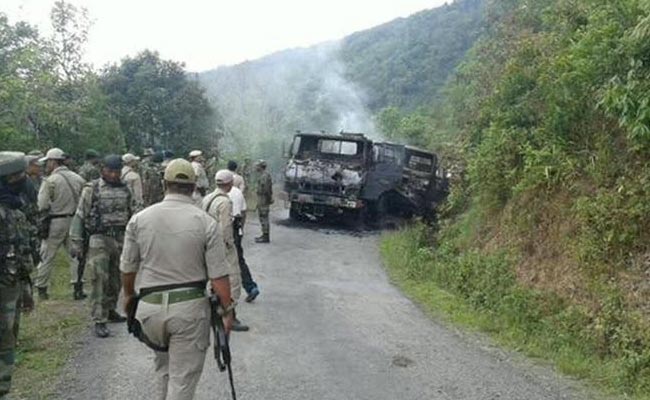The killing on June 4 in Manipur’s Chandel district of 20 Army personnel of the 6 Dogra Regiment was an incident waiting to happen. It is a miracle that such attacks have not taken place earlier and will be equally surprising if they don’t recur.
Given Manipur’s troubled past, there is something eerie about its tranquillity today. Once upon a time, Manipur used to be the most insurgency-affected State in the Northeast, with more than 30 outfits operating there. However, over the last five years (except 2012), the State has reported less than 100 insurgency-related deaths per year. Since 2008, the annual fatalities among security forces have remained below 20. This year, till the Chandel ambush took place, only two security personnel had been killed.
This shows that with arrests of key leaders and with defections and splits within militant outfits, militancy in Manipur is now at its weakest. However, the June 4 attack proves that even during a time of weakness, the militants have the capacity to carry out a serious strike.
Pointing at the Kanglei Yawol Kanna Lup (KYKL), People’s Liberation Army (PLA) or the Khaplang faction of the National Socialist Council of Nagaland (NSCN-K), or blaming the probable violation of standard operating procedures by Army personnel or the killing of a woman in firing by the Assam Rifles, mischievously linked to this ambush, are irrelevant.
The Myanmar link
It was hoped that Myanmar’s promised cooperation would end insurgency movements in the Northeast. On November 22, 2011, Mullappally Ramachandran, then Minister of State in the Ministry of Home Affairs, told the Lok Sabha, “The use of Myanmar’s territory by Indian Insurgent Groups (IIGs) for carrying out violence in Northeastern States has regularly been taken up at various high-level interactions between India and Myanmar every year. As a result of regular follow-up, [the] Government of Myanmar has shown willingness to act against separatist groups and has even taken some action against IIGs.” Three years after this optimistic speech, there has been no concrete action on Myanmar’s part. Kiren Rijiju, Minister of State for Home Affairs, told Parliament in August 2014 that the “IIGs continue to use Myanmar territory notwithstanding Myanmar’s repeated assurances not to allow its territory for activities inimical to India.”
This proves that without Myanmar’s cooperation — similar to how Bhutan in 2003 and Bangladesh since 2009 launched systematic clean-up operations — the problem of militancy in Manipur, Nagaland and Assam cannot be solved. Nothing short of a prolonged joint operation with the Indian security forces stationed on the Indo-Myanmar border will work.
Since the 1994 MoU, India and Myanmar have conducted annual security negotiations at two levels: the Home Secretary and the Joint Secretary level. On each occasion, Myanmar has assured India that it will not allow its soil to be used by IIGs. However, the assurances have remained confined to paper and press statements.
Myanmar suffers from two drawbacks that make peace along the border look extremely remote. One, it is still busy arriving at a country-wide ceasefire with the ethnic armed groups inside its borders, which includes the NSCN-K. Two, despite being supplied with weapons and equipment by India, its policies against the IIGs have never gone beyond small areas and short-duration operations. Advanced information continues to be passed on to the insurgents by Myanmar’s local military commanders, who receive protection money from these groups.
India’s own faults
India’s own efforts at ensuring some degree of border security along the porous 1,643-kilometre Indo-Myanmar border must come under some introspection. A paper submitted by the National Security Advisory Board in 2010 pointed to the fact that the 46-battalion strong Assam Rifles, the paramilitary force that guards the Indo-Myanmar border, is so short of strength that it stations its forces 40 kilometres away from the border. It deployed 31 battalions in counter-insurgency duties, leaving only 15 battalions to guard the risky border.
Moreover, operational control of the paramilitary force has remained a bone of contention between the Ministry of Home Affairs (MHA) and the Ministry of Defence. The proposal under the United Progressive Alliance government to replace Assam Rifles with the Border Security Force has been nixed by the present regime. The fact that MHA’s own assessments of the threats emanating from Myanmar are so out of sync with reality is evident from the following statement. On March 2, 2015, an MHA official told the media, “There is no real danger from any activities on the India-Myanmar border. In fact, there is a need to strengthen ties between the two countries and allow borderless travel and trade. Any additional build-up of force or change in deployment will send a wrong signal to the country which is our neighbour and friend.” Such laxity has resulted in the Indo-Myanmar border being guarded by a force that simply does not have the adequate numbers to foil militants or even arms and drug smugglers.
Now, the Home Minister has called for “strongest action” against the ambush on the Army personnel. This will only amount to a temporary area domination exercise; the militants would have fled to safety in Myanmar anyway. Just as the 2014 massacre by the National Democratic Front in Bodoland in Assam and the army operation that neutralised over 150 of its cadres did not result in the decimation of the outfit, militancy in Manipur will continue to survive. Reactive measures, as the history of insurgency in the Northeast tells us, have never achieved lasting results.
(Bibhu Prasad Routray, Director, Mantraya.org, served as a Deputy Director in the National Security Council Secretariat.)
